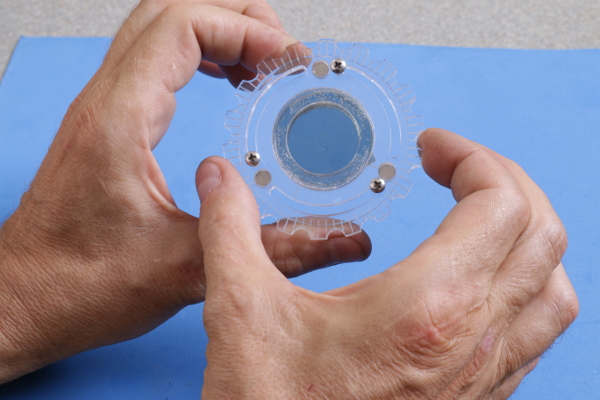Exotic Rings
#Shelf Ring

The shelf ring is for holding things horizontally in the optical axis, in the manner of a small table.
Shelf variations can hold prisms, cuvettes, and other small objects.
###Shelf Ring Construction

The shelf ring has three tab rectangles and three magnet holes that should be modified to suit your laser, as described in Before You Cut.
Insert the shelf base and shelf retainer into the notched hole at the bottom of the ring.
You may need to use a dab of glue to fix the base pieces in place.
#Cuvette Ring

The cuvette ring is a variation of the shelf ring for holding cuvettes.

The design has inserts for square and "H" style cuvettes.
Use the one that fits the type you have.
#Rotator Ring

The rotator ring allows the component to be rotated. This is normally used for polarized filters, but the project has an extra ring you can modify for other optics.

The lines on the outer edge are in 5-degree increments.
Just tighten one of the screws to set and keep a specific rotation.
###Rotator Ring Construction

The rotator is somewhat special because the edge lines are etched, not cut. These have to be selected and changed by hand in your own local copy.
For example, for our system from Rabbit Laser, we select all the degree lines and turn them green. Then we set the green color to 35% power, so that the lines are not cut all the way through the ring.

You can cut out polarized inserts for the rotation disk.

You will have to set the laser to "etch" the inner ring to make an insert for the polarizer disk, the polarized filter can be glued snugly within the etched depression.

For example, for our system from Rabbit Laser, we set the inner circle color to red. Then we set the red color to etch, so that the laser etches out the inside of the red inner circle.
#Selector Ring

This is actually a failed experiment. We were trying to make a ring selector with slits from thin brass sheet.
We were able to cut the brass on the laser, but it's a subtle process that takes a lot of tweaking to get right - we thought a lot of people would find this frustrating.
Still, the selector works, so we added the design to the project.
You can change the slits to holes and make an optics component selector if you like.
Maybe a selection of colored filters, or lenses of different focal lengths.
###Construction

The selector ring has three magnet holes that should be modified to suit your laser, as described in Before You Cut.
The screws can be 4-40 x 1/2" or M3x12, and the spring comes from a ball point pen.
You will need to drill a pocket in the side of the pawl and retaining block to hold the spring, as shown in the image at right.

The pocket holes can be easily drilled by clamping the piece (pawl or retaining block) to a larger piece of acrylic or wood, then using the larger piece as a brace for the drill.

This work is licensed under a Creative Commons Attribution-ShareAlike 4.0 International License.
